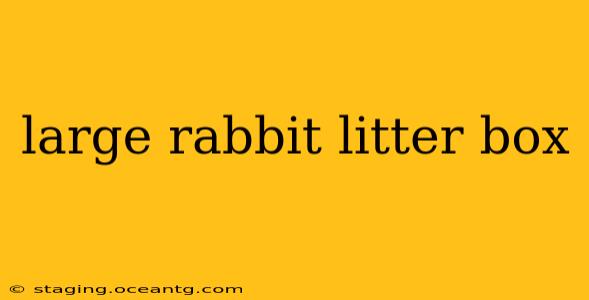Choosing the right litter box for your rabbit is crucial for maintaining a clean and healthy environment for both your pet and your home. A rabbit's size, breed, and litter habits all influence the ideal litter box dimensions. For larger breeds or multi-rabbit households, a large rabbit litter box is essential. This guide will delve into the key aspects of selecting the perfect spacious sanctuary for your furry friend's bathroom breaks.
What Size Litter Box Do I Need for My Rabbit?
This is the most frequently asked question regarding rabbit litter boxes. The simple answer? Bigger is usually better! Your rabbit should have ample space to comfortably move around and relieve themselves without feeling cramped. A box that's too small can lead to urine spraying outside the box, a common issue with unhappy bunnies. A good rule of thumb is to choose a litter box that's at least twice the size of your rabbit. For a large breed rabbit or multiple rabbits, a significantly larger box is necessary.
How Big is a "Large" Rabbit Litter Box?
The definition of "large" is relative and depends on your rabbit's size. However, consider these dimensions as a starting point:
- Small to Medium Rabbits: A litter box with a minimum floor area of 2 square feet (approximately 24 inches x 12 inches) is generally recommended.
- Large Breeds: Aim for a litter box with at least 3-4 square feet of floor space. This might involve using a large storage container or even a dedicated rabbit litter pan.
- Multiple Rabbits: If you have more than one rabbit, you’ll almost certainly need multiple large litter boxes, ideally one per rabbit plus one extra. Consider using multiple smaller boxes in different locations rather than one massive box.
What are the Best Types of Large Rabbit Litter Boxes?
There's no one-size-fits-all answer. Different litter box styles cater to various rabbit personalities and household preferences. Some popular options include:
- Plastic Storage Containers: These are affordable, readily available, and easy to clean. Look for containers with high sides to prevent litter scattering.
- Dedicated Rabbit Litter Pans: These are specifically designed for rabbits, often featuring high sides and a ramp for easier access.
- Corner Litter Boxes: These are space-saving solutions ideal for smaller living areas.
- Under-bed storage containers: These offer a concealed option, helping to keep the litter box out of sight.
How Often Should I Clean a Large Rabbit Litter Box?
Maintaining a clean litter box is paramount to your rabbit's health and your home's hygiene. Spot cleaning should be done daily, removing solid waste and wet spots. A complete litter box change with fresh bedding should occur at least once a week, more frequently if needed. The larger the box, the more litter it will hold, so this may reduce the frequency of full changes slightly but not daily cleaning.
What Type of Litter is Best for a Large Rabbit Litter Box?
Choosing the right litter is as important as choosing the right box. Opt for a litter that is:
- Dust-free: This is crucial for preventing respiratory issues in your rabbit.
- Absorbent: A highly absorbent litter minimizes odors and keeps the box dry.
- Safe for rabbits: Avoid litters containing clay or other potentially harmful materials. Paper-based or wood-pellet litters are generally good choices. Always check the ingredients list to ensure safety.
My Rabbit Still Pees Outside the Litter Box – What Should I Do?
If your rabbit is still urinating outside the litter box despite having a large, clean box, several factors could be at play:
- Medical issues: Urinary tract infections or other medical problems can cause inappropriate urination. Consult a veterinarian if you suspect a medical issue.
- Litter preference: Your rabbit might dislike the type of litter you're using. Experiment with different types to find one they prefer.
- Insufficient litter boxes: You may need more litter boxes strategically placed around your home.
- Stress or anxiety: Stress can cause inappropriate urination. Identify and address any potential stress triggers in your rabbit's environment.
By following these guidelines and addressing any underlying issues, you can ensure your rabbit has a comfortable and hygienic bathroom experience, resulting in a happier and healthier pet and a cleaner home for you.
